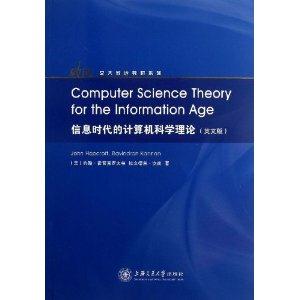预估到手价是按参与促销活动、以最优惠的购买方案计算出的价格(不含优惠券部分),仅供参考,未必等同于实际到手价。
-
>
全国计算机等级考试最新真考题库模拟考场及详解·二级MSOffice高级应用
-
>
决战行测5000题(言语理解与表达)
-
>
软件性能测试.分析与调优实践之路
-
>
第一行代码Android
-
>
C Primer Plus 第6版 中文版
-
>
深度学习
-
>
MATLAB计算机视觉与深度学习实战-赠在线交流卡和本书源码
信息时代的计算机科学理论-(英文版) 版权信息
- ISBN:9787313096098
- 条形码:9787313096098 ; 978-7-313-09609-8
- 装帧:一般胶版纸
- 册数:暂无
- 重量:暂无
- 所属分类:>
信息时代的计算机科学理论-(英文版) 本书特色
《信息时代的计算机科学理论(英文版)》是上海交通大学致远教材系列之一,由国际著名计算机科学家约翰·霍普克罗夫特教授和拉文德兰·坎南教授编写。本书包含了高维空间、随机图、奇异值分解、随机行走和马尔可夫链、学习算法和VC维、大规模数据问题的算法、聚类、图形模型和置信传播等主要内容,书后有附录及索引。从第2章开始,每章后面均附有适量的练习题。 本书可作为计算机及相关专业高年级本科生或研究生的教材,也可供相关专业技术人员参考。
信息时代的计算机科学理论-(英文版) 内容简介
《信息时代的计算机科学理论(英文版)》是交大致远教材系列之一,由约翰·霍普克罗夫特编著。《信息时代的计算机科学理论(英文版)》简介:Computer Science Theory for the Information Age covers the computer science theory likely to be useful in the next 40 years, including high- dimensional space, random graphs, singular value decomposition. random walks, Markov chains, learning algorithms, VC-dimension, algorithms for massive date problems, clustering. The book also covers graphical models and belief propagation, ranking and voting, sparse vectors, and compressed sensing.The book is intended for either an undergraduate or a graduate theory course in computer science.Prof. John Hopcroft is a world-renowned scientist and an expert on education in computer science. He was awarded the A. M. Turing Award in 1986 for his contributions in theoretical computing and data structure design. Dr. Ravindran Kannan is a principal researcher with Microsoft Research Labs located in India.
信息时代的计算机科学理论-(英文版) 目录
- >
我与地坛
我与地坛
¥16.8¥28.0 - >
李白与唐代文化
李白与唐代文化
¥9.9¥29.8 - >
上帝之肋:男人的真实旅程
上帝之肋:男人的真实旅程
¥19.3¥35.0 - >
经典常谈
经典常谈
¥17.1¥39.8 - >
龙榆生:词曲概论/大家小书
龙榆生:词曲概论/大家小书
¥9.1¥24.0 - >
罗曼·罗兰读书随笔-精装
罗曼·罗兰读书随笔-精装
¥40.6¥58.0 - >
人文阅读与收藏·良友文学丛书:一天的工作
人文阅读与收藏·良友文学丛书:一天的工作
¥16.0¥45.8 - >
回忆爱玛侬
回忆爱玛侬
¥10.5¥32.8
-
python 程序设计实用教程
¥38.3¥54 -
2022图书×抽奖盲袋
¥9.9¥25 -
2023读书月阅读盲盒——天黑,闭眼,刀谁?
¥42.3¥158 -
2022读者节纪念徽章-三星会员专属
¥45¥45.6















